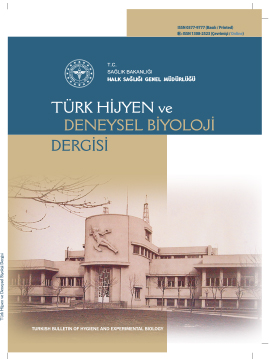
Bu eser Creative Commons Alıntı-GayriTicari-Türetilemez 4.0 Uluslararası Lisansı ile lisanslanmıştır.













The role of Brucella abortus strains in the abortion etiology of domestic ruminants in the Cukurova region, Turkey and molecular epidemiological characteristics
Süleyman ASLAN1, Tülay KANDEMİR2, Nur Sima UPRAK2, Toğrul NAĞIYEV21Ministry of Agriculture and Forestry, General Directorate of Agricultural Research and Policies, Ankara, Türkiye2Cukurova University, Faculty of Medicine, Department of Medical Microbiology, Adana, Türkiye
INTRODUCTION: Brucellosis caused by bacteria of the Brucella genus is a globally important zoonotic disease. B. abortus, which usually causes abortion and infertility in cows, can cross-infect ruminants and also cause chronic disease in humans. Controlling outbreaks in ruminants is essential to prevent economic losses and human disease due to bovine brucellosis. Since classical phenotypic methods alone are insufficient in monitoring epidemic strains of B. abortus, genotypic surveillance has become crucial today. We aimed to determine the role of B. abortus strains in the abortion etiology of domestic ruminants in the Cukurova region, Türkiye, reveal the phylogenetic relationships of the isolated strains using molecular methods and examine the availability of these methods in this field.
METHODS: One hundred eighteen abortion samples were included in the study. Following the isolation and identification of B. abortus, the clonal relationship between these isolates was investigated by Pulse-Field Gel Electrophoresis (PFGE) and Multi-Locus Variable Number Tandem Repeat Analysis (MLVA) methods.
RESULTS: B. abortus was detected in 17 (14.4%) of 118 abortion cases examined. The distribution of B. abortus isolates among cattle, goats and sheep was 72.2% (13/18), 5.9% (3/51) and 2.0% (1/49), respectively. The 14 (82.4%) of B. abortus isolates were biovar 3. A single cluster and four pulsotypes (HGDI=0.5662) were determined by the PFGE, five types (HGDI=0.6838) by the MLVA-16, and six genotypes (HGDI=0.7132) by evaluating these two methods together. Genotype 1, which consists of nine (52.9%) isolates, six obtained from cattle and three from goats, was predominant.
DISCUSSION AND CONCLUSION: Although the discriminative powers of the PFGE and MLVA methods were not high enough when a small number of samples were examined, the discriminatory power of MLVA-16 was determined to be higher than PFGE in determining the regionally predominant B. abortus genotypes. Moreover, the use of both together was even more effective. Since using the two methods together in epidemiological studies requires additional costs and effort, it was concluded that the predominant genotypes could be determined, especially during epidemic periods and evaluated in vaccine studies. Additional examination of human clinical specimens in epidemic areas will further strengthen the results to be obtained. Thus, our study will provide essential data for the studies to be performed in order to control brucellosis outbreaks, which constitute a serious public health problem.
Türkiye’nin Çukurova bölgesinde evcil ruminantların düşük etiyolojisinde Brucella abortus suşlarının rolü ve moleküler epidemiyolojik özellikleri
Süleyman ASLAN1, Tülay KANDEMİR2, Nur Sima UPRAK2, Toğrul NAĞIYEV21Tarım ve Orman Bakanlığı, Tarımsal Araştırmalar ve Politikalar Genel Müdürlüğü, Ankara, Türkiye2Çukurova Üniversitesi Tıp Fakültesi, Tıbbi Mikrobiyoloji Anabilim Dalı, Adana, Türkiye
GİRİŞ ve AMAÇ: Brucella cinsi bakterilerin sebep olduğu bruselloz dünya çapında önemli zoonotik bir hastalıktır. Genellikle ineklerde düşüğe ve kısırlığa sebep olan B. abortus ruminantlar arasında çapraz enfeksiyon yapabilmekte, insanlarda da kronik hastalık oluşturabilmektedir. Ruminantlarda salgınların kontrol altına alınması sığır brusellozuna bağlı ekonomik kayıpların ve insanlardaki hastalığın önlenmesi için esastır. Salgın suşlarının izlenmesinde klasik fenotipik yöntemler tek başına yeterli olmadığından günümüzde genotipik sürveyans önem kazanmıştır. Çalışmamızda, Türkiye’nin Çukurova bölgesinde evcil ruminantların düşük etiyolojisinde B. abortus suşlarının rolünün belirlenmesi, izole edilen suşların filogenetik ilişkilerinin moleküler yöntemlerle ortaya çıkartılması ve bu yöntemlerin bu alanda uygulanabilirliğinin sorgulanması amaçlanmıştır.
YÖNTEM ve GEREÇLER: Çalışmaya 118 düşük örneği dahil edilmiştir. B. abortus izolasyonu ve identifikasyonunu takiben bu izolatlar arasındaki klonal ilişki Pulse-Field Gel Electrophoresis (PFGE) ve Multi-Locus Variable Number Tandem Repeat Analysis (MLVA) yöntemleri ile araştırılmıştır.
BULGULAR: İncelenen toplam 118 düşük vakasından 17 (%14,4)’sinde B. abortus tespit edilmiştir. Sığır, keçi ve koyunlardaki B. abortus izolatlarının dağılımı sırasıyla %72,2 (13/18), %5,9 (3/51) ve %2,0 (1/49) idi. B. abortus izolatlarının üçü biyotiplendirilememişken, 14’ünün (%82,4) biovar 3 olduğu tespit edilmiştir. PFGE ile tek küme ve 4 pulsotip (HGDI=0,5662), MLVA-16 ile 5 tip (HGDI=0,6838), iki yöntem birlikte değerlendirildiğinde de 6 genotip (HGDI=0,7132) belirlenmiştir. Altısı sığırdan, üçü de keçiden elde edilmek üzere 9 (%52,9) izolatı barındıran genotip 1’in baskın olduğu görülmüştür.
TARTIŞMA ve SONUÇ: PFGE ve MLVA yöntemlerinin ayırt edici güçleri az sayıda örnek incelendiğinde yeterince yüksek bulunmasa da, bölgesel hakim B. abortus genotiplerinin belirlenmesinde MLVA-16’nın ayırt edici gücünün PFGE’ye göre daha yüksek olduğu, ikisinin birlikte kullanılmasının ise daha da etkili olduğu belirlenmiştir. İki yöntemin epidemiyolojik çalışmalarda bir arada kullanılmasının ek maliyet ve zahmet gerektirmesi sebebiyle, özellikle salgın dönemlerinde baskın genotiplerin tespit edilerek aşı çalışmalarında değerlendirilebileceği kanaatine varılmıştır. Salgın bölgelerinde insan klinik örneklerinin de ek olarak incelenmesi elde edilecek sonuçları daha da güçlendirecektir. Sonuç olarak çalışmamız, ciddi bir halk sağlığı sorunu oluşturan bruselloz salgınlarının kontrol altına alınabilmesi için yapılacak çalışmalara önemli veri sağlayacaktır.
Manuscript Language: English
(542 downloaded)


